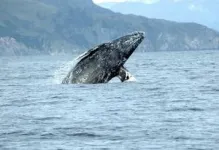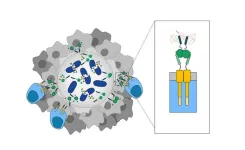(Press-News.org) NEWPORT, Ore. – Dynamic and changing Arctic Ocean conditions likely caused three major mortality events in the eastern North Pacific gray whale population since the 1980s, a new study has found.
During each of these die-offs, including one that began in 2019 and is ongoing, the gray whale population was reduced by up to 25% over just a few years, said Joshua Stewart, an assistant professor with Oregon State University’s Marine Mammal Institute and the study’s lead author.
“These are extreme population swings that we did not expect to see in a large, long-lived species like gray whales,” Stewart said. “When the availability of their prey in the Arctic is low, and the whales cannot reach their feeding areas because of sea ice, the gray whale population experiences rapid and major shocks.”
“Even highly mobile, long-lived species such as gray whales are sensitive to climate change impacts. When there are sudden declines in the quality of prey, the population of gray whales is significantly affected.”
The findings were just published in the journal Science.
Eastern North Pacific gray whales are one of the few populations of large whales that have recovered to what may be similar numbers that existed prior to commercial whaling. As the population has approached levels close to what their Arctic feeding areas can support, they have likely become more sensitive to environmental conditions due to competition for limited resources, Stewart said.
The unfavorable Arctic conditions that led to two die-offs in the 1980s and the 1990s were not permanent, and the population quickly rebounded as conditions improved.
“It turns out we didn’t really know what a healthy baleen whale population looks like when it isn’t heavily depleted by human impacts,” he said. “Our assumption has generally been that these recovering populations would hit their environmental carrying capacities and remain more or less steady there. But what we’re seeing is much more of a bumpy ride in response to highly variable and rapidly changing ocean conditions.”
Eastern North Pacific gray whales, which currently number about 14,500, migrate more than 12,000 miles each year along the Pacific Coast, from the warm waters off the coast of Baja California, Mexico, in the winter months to the cold, productive waters of the Arctic to feed in the summer months.
Researchers at the National Oceanic and Atmospheric Administration Southwest Fisheries Science Center in La Jolla, California, have been conducting long-term population monitoring studies of these whales since the 1960s, tracking abundance, birth and death rates and monitoring body condition using aerial images. This extensive research has made this population of gray whales the most closely studied large whale population on the planet, providing a unique window into the population dynamics of the species.
“This research demonstrates the value of long-term data in understanding not only the species under study but also the environment it depends on,” said Dave Weller, director of the Southwest Fisheries Science Center’s Marine Mammal and Turtle Division. “When we began collecting data on gray whales in 1967, little did we realize the important role they would play in understanding the effects of climate change on an iconic sentinel species in the Pacific. This research would not have been possible without our reliable long-term record.”
The eastern North Pacific gray whale population, which was hunted to near extinction before a whaling moratorium was enacted, has been viewed as a conservation success story because of the population’s rapid recovery in the post-whaling era.
In 2019, when a high number of gray whale strandings began occurring along the Pacific coast, Stewart, a researcher at the Southwest Fisheries Science Center at the time, began looking more closely at the long-term data to see if he could learn more about what might be driving the unusual mortality event.
By combining the long-term data sets on the gray whale population with extensive environmental data from the Arctic, Stewart and his collaborators determined that the two “Unusual Mortality Events” declared by NOAA in 1999 and 2019 were tied to both sea ice levels in the Arctic and the biomass of seafloor-living crustaceans that gray whales target for food.
Stewart also identified a third die-off in the 1980s that followed a similar pattern but was not associated with higher numbers of strandings, likely due to lower reporting rates of stranded whales prior to the 1990s.
The researchers found that years with less summer sea ice in the gray whales’ Arctic feeding areas provided increased foraging opportunities that benefited the population. However, in the long term, decreasing sea ice cover, a result of rapid and accelerating climate change, most likely will not be beneficial to gray whales.
Benthic amphipods, the calorie-rich prey that gray whales prefer, are also sensitive to sea ice cover. Algae that grow underneath sea ice sink to the seafloor, enriching the amphipod population. Less ice leads to less algae reaching the seafloor, warmer water that favors smaller benthic crustaceans and faster currents that reduce habitat for gray whales’ preferred prey.
“With less ice, you get less algae, which is worse for the gray whale prey,” Stewart said. “All of these factors are converging to reduce the quality and availability of the food they rely on.”
For the gray whales, less prey availability ultimately leads to die-offs. The most recent event is still considered ongoing and has continued significantly longer than the two earlier events.
“We are in uncharted territory now. The two previous events, despite being significant and dramatic, only lasted a couple of years,” Stewart said. “The most recent mortality event has slowed and there are signs things are turning around, but the population has continued to decline. One reason it may be dragging on is the climate change component, which is contributing to a long-term trend of lower-quality prey.”
Gray whales have lived through hundreds of thousands of years of environmental change and have adapted over that time to changing conditions, making extinction due to climate change unlikely, Stewart said.
“I wouldn’t say there is a risk of losing gray whales due to climate change,” he said. “But we need to think critically about what these changes might mean in the future. An Arctic Ocean that has warmed significantly may not be able to support 25,000 gray whales like it has in the recent past.”
Coauthors of the study include Trevor W. Joyce of Ocean Associates; John Durban of the Marine Mammal Institute and Sealife Response, Rehabilitation and Research; John Calambokidis of Cascadia Research Collective; Deborah Fauquier of the NOAA Fisheries Office of Protected Resources; Holly Fearnbach of SR3; Jacqueline Grebmeier of the University of Maryland Center for Environmental Science; Morgan Lynn, Wayne Perriman of the Southwest Fisheries Science Center, NOAA Fisheries; Manfredi Manizza of the Scripps Institution of Oceanography, University of California, San Diego; and Tim Tinker of Nhydra Consulting and University of California, Santa Cruz.
The Marine Mammal Institute is part of Oregon State’s College of Agricultural Sciences and is based at Hatfield Marine Science Center in Newport.
END
Gray whales experience major population swings as a result of Arctic conditions, research shows
2023-10-12
ELSE PRESS RELEASES FROM THIS DATE:
Cell atlases of the human brain presented in Science
2023-10-12
In two parallel projects, researchers at Karolinska Institutet have been involved in creating the most comprehensive atlases of human brain cells to date. The two studies, which are published in Science, provide clues on different brain diseases and give hope for medical advancements in the future, such as new cancer drugs.
Knowing what cells constitute the healthy brain, where different cell types are located and how the brain develops from the embryo stage is fundamental to the ability to compare and better understand how diseases arise. There are at present advanced atlases of the ...
Coffee and cocoa plants at risk from pollinator loss
2023-10-12
Tropical crops such as coffee, cocoa, watermelon and mango may be at risk due to the loss of insect pollinators, finds a new study led by UCL and Natural History Museum researchers.
Published in Science Advances, the study explores the intricate interplay between climate change, land use change, and their impact on pollinator biodiversity, ultimately revealing significant implications for global crop pollination.
The study, which compiled data from 1,507 crop growing sites around the world and catalogued 3,080 insect pollinator species, exposes a concerning trend – the combined pressures ...
Scientists unveil detailed cell maps of the human brain and the nonhuman primate brain
2023-10-12
A group of international scientists have mapped the genetic, cellular, and structural makeup of the human brain and the nonhuman primate brain. This understanding of brain structure, achieved by funding through the National Institutes of Health’s Brain Research Through Advancing Innovative Neurotechnologies® Initiative, or The BRAIN Initiative®, allows for a deeper knowledge of the cellular basis of brain function and dysfunction, helping pave the way for a new generation of precision therapeutics for people with mental disorders and other disorders of the brain. The findings appear in a compendium of ...
Engineered bacteria paint targets on tumors for cancer-killing T cells to see
2023-10-12
New York, NY—October 12, 2023—For several years, researchers have been successfully using chimeric antigen receptor (CAR) T cells to target specific antigens found on blood cells as a cure for patients with leukemia and lymphoma. But solid tumors, like breast and colon cancers, have proven to be more difficult to home in on. Solid tumors contain a mix of cells that display different antigens on their surface-often shared with healthy cells in the body. Thus, identifying a consistent and safe target has impeded the success of most CAR-T cell therapy for solid tumors at the first phase ...
How do tax proposals affect cancer health of tobacco users based on income, education?
2023-10-12
Tobacco is the leading cause of preventable death in the United States, according to the Centers for Disease Control and Prevention, and cigarette smoking causes three in 10 of all cancer deaths. Smoking also accounts for more than 30 percent of the difference in life expectancy among different socioeconomic groups.
Roberta Freitas-Lemos, research assistant professor at the Fralin Biomedical Research Institute at VTC, recently received a career development award to explore the ways in which nicotine tax policies can influence health disparities. The award of more than $680,000 over five years from the National Cancer Institute of the National Institutes of Health is designed ...
NIH awards Mount Sinai researchers $12 million to personalize sickle cell treatment
2023-10-12
New York, NY (October 12, 2023) - The Mount Sinai Health System has received a $12,180,625 grant from the National Heart, Lung and Blood Institute to compare new treatment options for sickle cell disease and determine which work best for specific patients.
“Sickle cell traditionally has been a neglected disease, but it benefited from a flurry of innovation over the last decade and there are now three new medications approved for the disease,” says Jeffrey Glassberg, MD, Director of the Mount Sinai Sickle Cell Program.
“While this is welcome news, clinicians now have a new challenge. ...
Caution: Content warnings do not reduce stress, study shows
2023-10-12
Advocates for the use of trigger warnings suggest that they can help people avoid or emotionally prepare for encountering content related to a past trauma. But trigger warnings may not fulfill either of these functions, according to an analysis published in Clinical Psychological Science, a journal of the Association for Psychological Science.
Instead, warnings appear to heighten the anticipatory anxiety a person may feel prior to viewing sensitive material while making them no less likely to consume that content, wrote Victoria M. E. Bridgland of ...
New catalyst could provide liquid hydrogen fuel of the future
2023-10-12
Researchers at Lund University in Sweden are investigating a car fuel comprised of a liquid that is converted to hydrogen by a solid catalyst. The used liquid is then emptied from the tank and charged with hydrogen, after which it can be used again in a circular system that is free from greenhouse gas emissions.
In two research articles, Lund researchers have demonstrated that the method works, and while it is still basic research, it has the potential to become an efficient energy-storage system in the future.
“Our catalyst is one of the most efficient around, at least if you look at publicly available research,” says Ola ...
Froedtert Health, Wisconsin Diagnostic Laboratories and HealthEco launch Atalan, a technology-enabled clinical partnership providing access to the best in laboratory medicine
2023-10-12
FROEDTERT HEALTH, WISCONSIN DIAGNOSTIC LABORATORIES AND HEALTHECO LAUNCH ATALAN, A TECHNOLOGY-ENABLED CLINICAL PARTNERSHIP PROVIDING ACCESS TO THE BEST IN LABORATORY MEDICINE
Atalan’s Access Hub Connects Doctors and Medical Centers to a Vetted Network of the Nation’s Foremost Clinical Laboratories to Improve Patient Diagnostics and Care
MILWAUKEE, Oct. 12, 2023 – Froedtert Health, Wisconsin Diagnostic Laboratories (WDL) and HealthEco announced today the launch of Atalan, a technology-enabled clinical partnership providing doctors and medical centers unprecedented access to a vetted network of the nation’s ...
Texas A&M-led team receives USDA grant to study cattle respiratory disease prevention
2023-10-12
Researchers from the Veterinary Education, Research, & Outreach (VERO) program at the Texas A&M School of Veterinary Medicine & Biomedical Sciences (VMBS) have received $300,000 from the United States Department of Agriculture’s National Institute of Food and Agriculture to study the costliest disease in the cattle industry, bovine respiratory disease (BRD).
The grant will fund a highly collaborative project involving Mississippi State University, West Texas A&M University and Texas A&M ...





